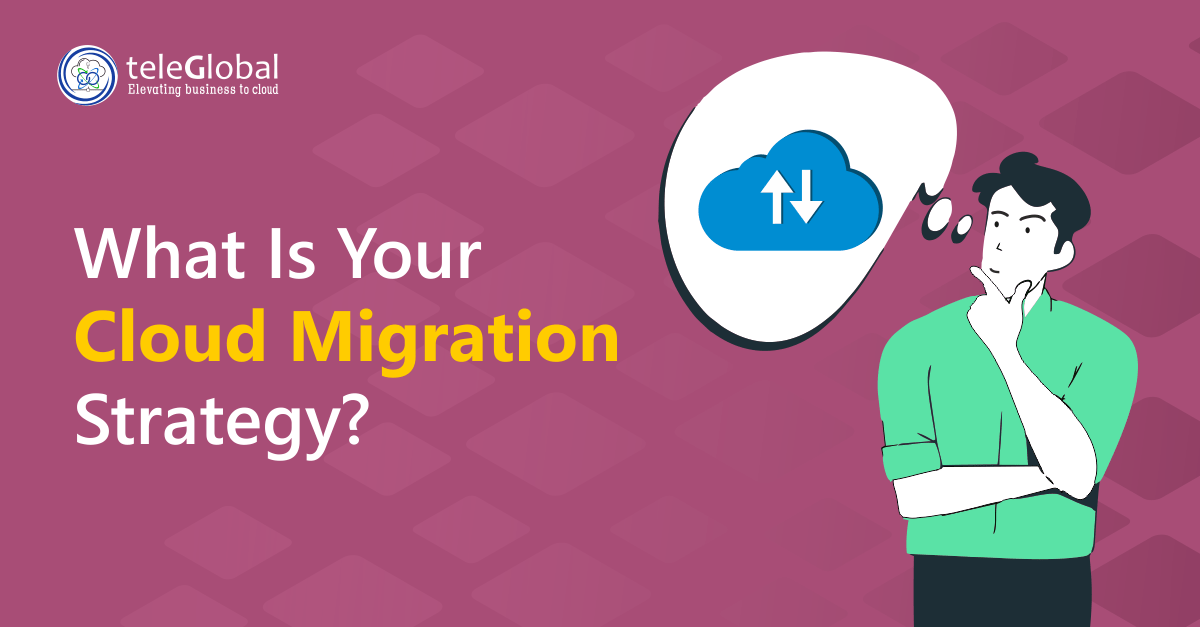Published Date :
The first step in understanding your cloud migration strategy is to understand the concept of the cloud and migration.
The Cloud is a scalable set of virtual networks, consisting of online servers operating out of a global network of data centers.
Cloud migration is simply the process of moving all digital assets, system resources, databases, and computing processes to these servers. The superb results enjoyed by companies like Netflix, Spotify, and Etsy, who have successfully migrated are certainly tempting. And it may be tempting to take a one-and-done approach, but organizations need to take a step back and map out the entire migration process. Viz. considering factors such as database size and complexity, interoperability, and of course budgets.
Types of Cloud Migrations
There are seven different approaches that an organization can take to move its workloads to the cloud. Also known as the 7 R’s, they range from simple to complex, and least to most effective. Engaging with a Cloud Consultant to work with your team ensures a complete view of all infrastructure elements and options available correctly move your workloads through every stage of your migration. Here are some of the most common types of cloud migration strategies.
1 . Rehosting
This is one of the simplest cloud migration models and is also popularly referred to as ‘lift-and-shift’. As this name implies it simply involves taking existing applications, server operating systems, and more from your existing hosting environment and moving them to the public cloud infrastructure without any changes. Of course, the downside of this is that your systems and applications won’t be designed to operate in the cloud environment, so you will simply be repeating many of the same patterns of your on-premises environment.
2 . Relocate
The Relocate strategy lets you use the same hardware, applications, and systems, and even during relocation, users continue to be served. This doesn’t impact the architecture of your application, making it the quickest way to migrate and operate your workloads. You can use this strategy to transfer many servers at a given time. You can also use this strategy in AWS to move instances to different AWS Regions or AWS accounts.
3 . Replatforming
Instead of ‘Lift-and’shift’, consider this as a lift-tweak-shift approach. This too basically moves the same environment to the cloud—with one important difference. Here you make the most important, or bare minimum, changes needed to make the transition successful. Core application architecture is not changed in any way. This is a variation on rehosting, and, like rehosting, doesn’t enable you to take full advantage of the cloud’s benefits.
4 . Repurchasing
One of the biggest motivations to move to the cloud is the increasing difficulty and expense of maintaining legacy applications and systems. In such instances, switching to a better and more cloud-native model makes better sense. A good example is in-house customer relationship management (CRM) systems vs Salesforce’s cloud-based CRM solution.
This approach is especially cost-effective if your legacy system is approaching obsolescence and requires too much time and effort and resources to manage. The only downside of moving to a new system is that there is a certain learning curve to attain proficiency with the new system.
5. Refactoring
Refactoring comes with a certain cost that can be daunting, but it is the strategy that offers the biggest dividends in the long run. Refactoring consists of essentially rebuilding the entire existing infrastructure from scratch. This allows organizations to leverage every single advantage that the cloud has to offer, such as autoscaling and serverless computing, which are difficult, if not impossible, to achieve in an on-premises setup.
6 . Retiring
It is often not necessary to scrap an entire ecosystem and start again from scratch, as refactoring requires. Instead, organizations can identify components of the infrastructure that have become obsolete or will become inconsequential after moving to the cloud. These components can pose security vulnerabilities, as well. In such instances, it makes sense to retire these components, i.e. not move them to the cloud.
7 . Retaining
This becomes a necessary solution when necessary components of the existing infrastructure may not be compatible with available cloud platforms. For instance, data that cannot be moved for regulatory reasons. It could also involve architecture that may only recently have been built and the expense. In such cases, it just makes more sense—financially and operationally—to retain these modules on-premises.
Stages of Cloud Adoption
Your cloud migration strategy should set out the most effective order to migrate applications to the new infrastructure. There are many approaches to cloud migration, but the steps remain basically the same, and the attendant considerations are as well.
Three Stages/Steps to Cloud Migration
Pre-Migration
Your migration starts with crafting a thought-through strategy to start the transition. The biggest factor in this step is the focus on migration workload analysis.
Migration
This is the middle stage when the actual transition takes place. It involves consideration of all cloud deployment practices and availability. And is done only after the environment has been properly assessed.
Post-Migration
This is the longest stage in your migration strategy as it considers everything that happens after the transition, including post-migration support, upgrades, troubleshooting, and more. Since cloud technology is constantly evolving, it also means that the optimization of your applications and systems will also move in concert. Docker containers, for instance, didn’t exist before 1979, neither did microservices, and serverless computing began as late as 2008.
Key Considerations in Cloud Migration
Organizations move to the cloud to help grow their business, stay competitive, improve security or cut costs. Cloud adoption is a key step in embracing digital transformation, nevertheless, organizations often overlook some of its constituent aspects, like cloud migration workflow models, strategies, and approaches. Those companies should consider all necessary factors before migrating to the cloud.
Staff training
If your people are not familiar with cloud services or know how cloud services work in other business environments, the entire migration will be a waste. So, it is critical to first train your employees on what is needed and how they must deliver on their KRAs.
Application dependencies
There are application integration capabilities and dependencies that may not be immediately obvious or become manifest only after the transition. It is important to understand these inter-application dependencies to successfully migrate to the cloud. And it is far better to delay migration until there is a clear understanding, rather than try and invent work-around solutions after the transition has taken place.
Infrastructure stack
The cloud offers a hierarchy of deployment models including SaaS, IaaS, and PaaS. Organizations need to explore these options to decide the best-suited environment for their needs. Understanding these models allows organizations to understand which architectures—if any—need to be changed so they can adapt and align their cloud infrastructure for the transition.
Every service you might require is available in the cloud, and the Cloud Service Provider offers a set of services that make up your IT infrastructure, but you need to make sure you pick the ones that correctly match your needs. For instance, your IT workload might need a complete execution stack including servers, OS, networking, and storage. These components must meet your needs: is it the OS your applications need? Our application code changes needed, and how extensive? Is the CPU robust enough? Are there multi-core facilities that you can leverage? Can instances be configured with sufficient RAM? Does the CSP provide the different storage technologies and the required access times at rates that meet your satisfaction?
Determining correct resources and availability optimizes the usage of company resources, and allows you to design your cloud environment better and get the most from your migration.
Workload analysis
Not all of your IT workloads running in your data center may be appropriate for migrating to the cloud. It isn’t always easy but you need to consider all aspects of the execution environment. For instance, can you achieve the same level of capacity, performance, utilization, security, and availability or do better given the service parameters promised by the provider? What happens in the future? Will the cloud infrastructure scale in tandem with your resource consumption? Will your application meet regulatory compliance when hosted in the public cloud? It is important to thoroughly understand current workloads and determine how closely their requirements, both for the present and future, can be met by the CSP.
Systems compatibility
In any cloud transition, it is important to have the latest operating system, middleware, and database versions. If not, you could likely have errors, which will only multiply in the future. Cloud migration isn’t just about how you manage it, but also about determining how sensitive data will be handled during and after the transition.
User experience
Without considering the effect on the user experience, digital transformation is of limited benefit to your business. Therefore, when deciding to implement new cloud migration strategies, organizations should also monitor application usage, and identify post-migration impact.
Conclusion
Moving to the cloud brings many advantages including increased agility, high efficiency, better availability, resilience, security, and provides a better customer experience, and saves on costs. But cloud migration can be a complex task, and organizations implementing cloud migration should consider several important factors before beginning the transition to the cloud. These extend from the choice of Cloud Service Provider to Migration Strategies to factors to consider before transitioning to the cloud. The importance of a reliable Cloud Service provider cannot be overstated. Cloud adoption is no longer a luxury, it is now a critical part of IT optimization. All of this makes the migration strategy all the more imperative.
Need help with your cloud?
"No worries! Our experts are here to help you. Just fill the form and we'll get back to you shortly!"
Our Partners


 +919356301699
+919356301699 hello@anetautomation.com
hello@anetautomation.com
